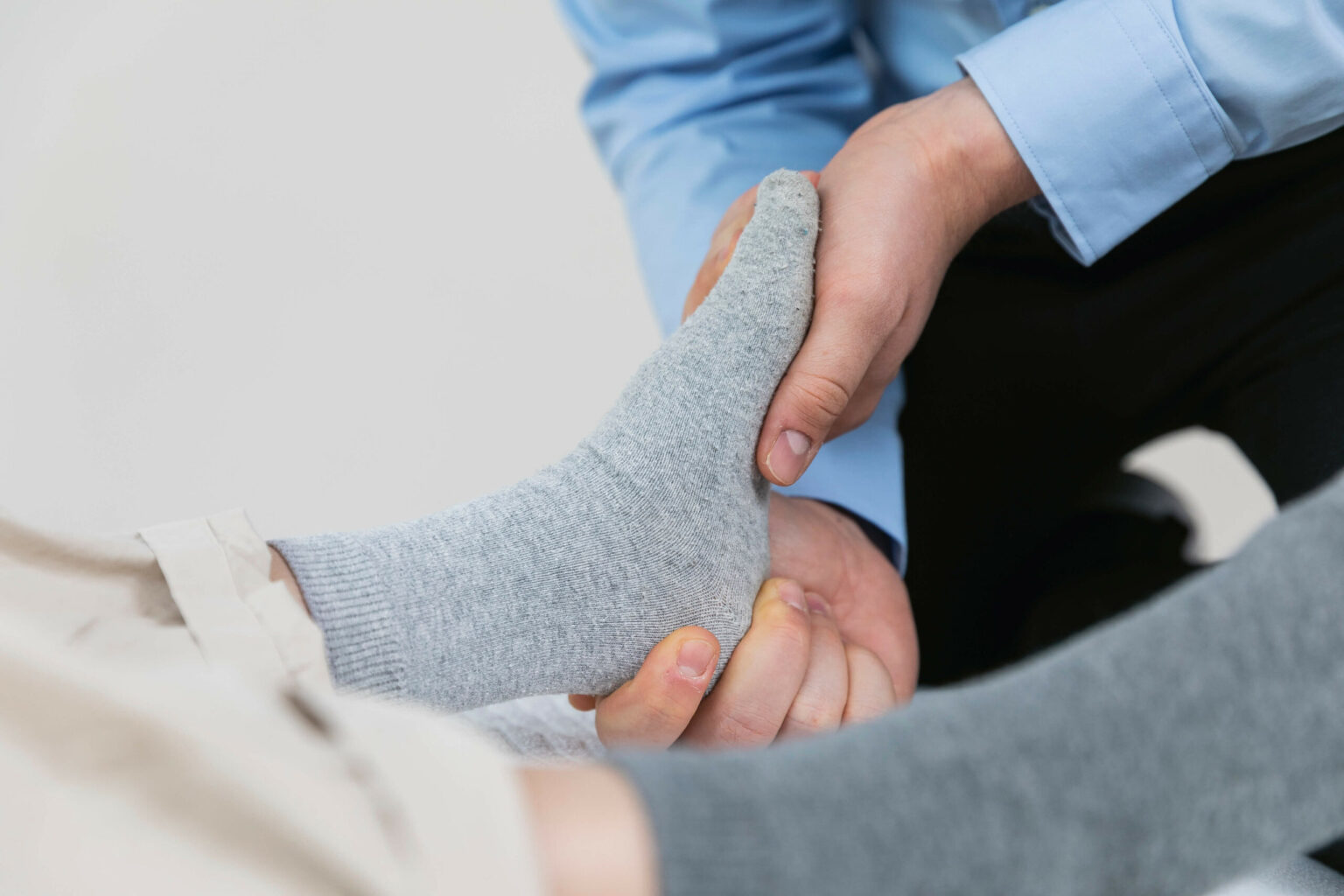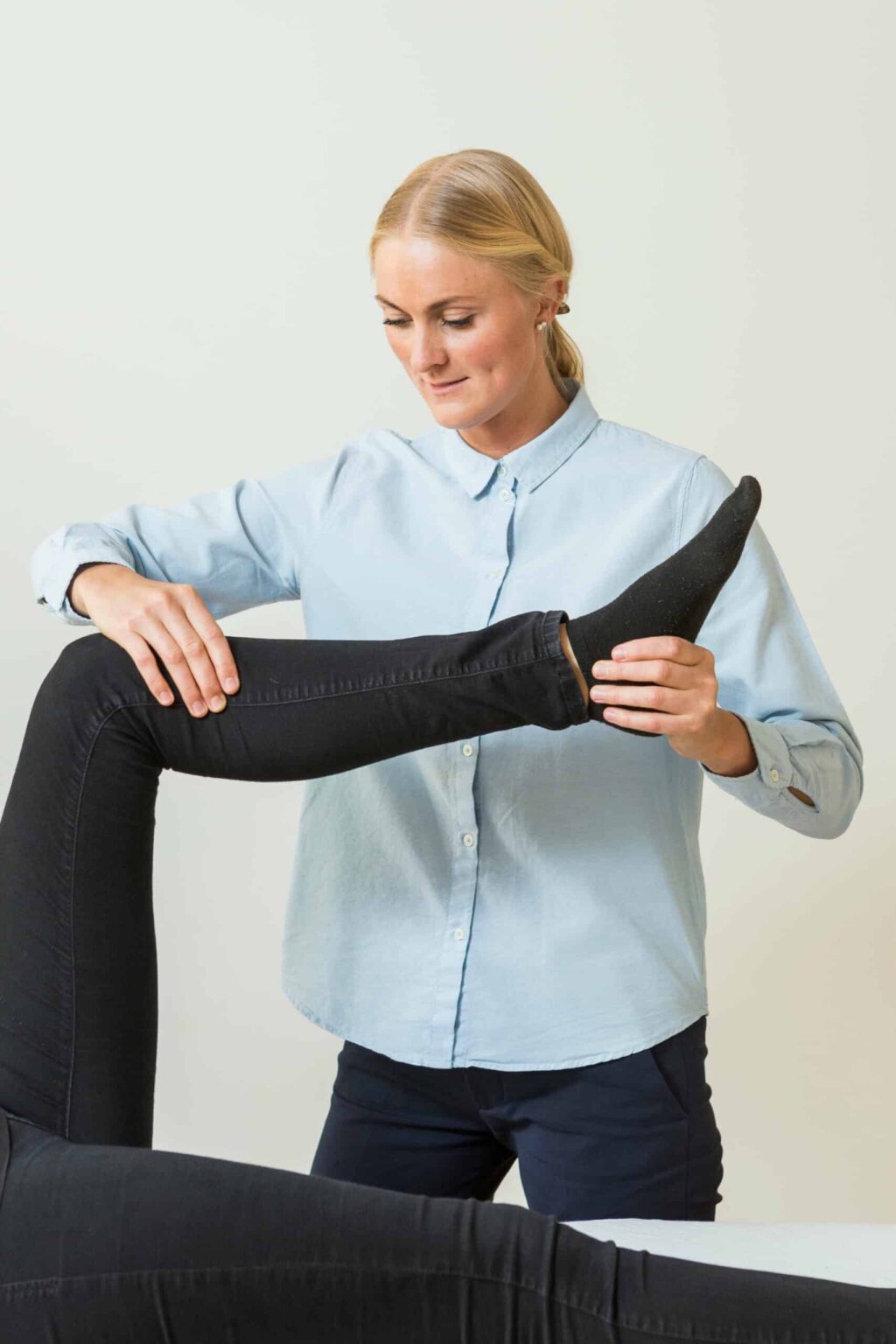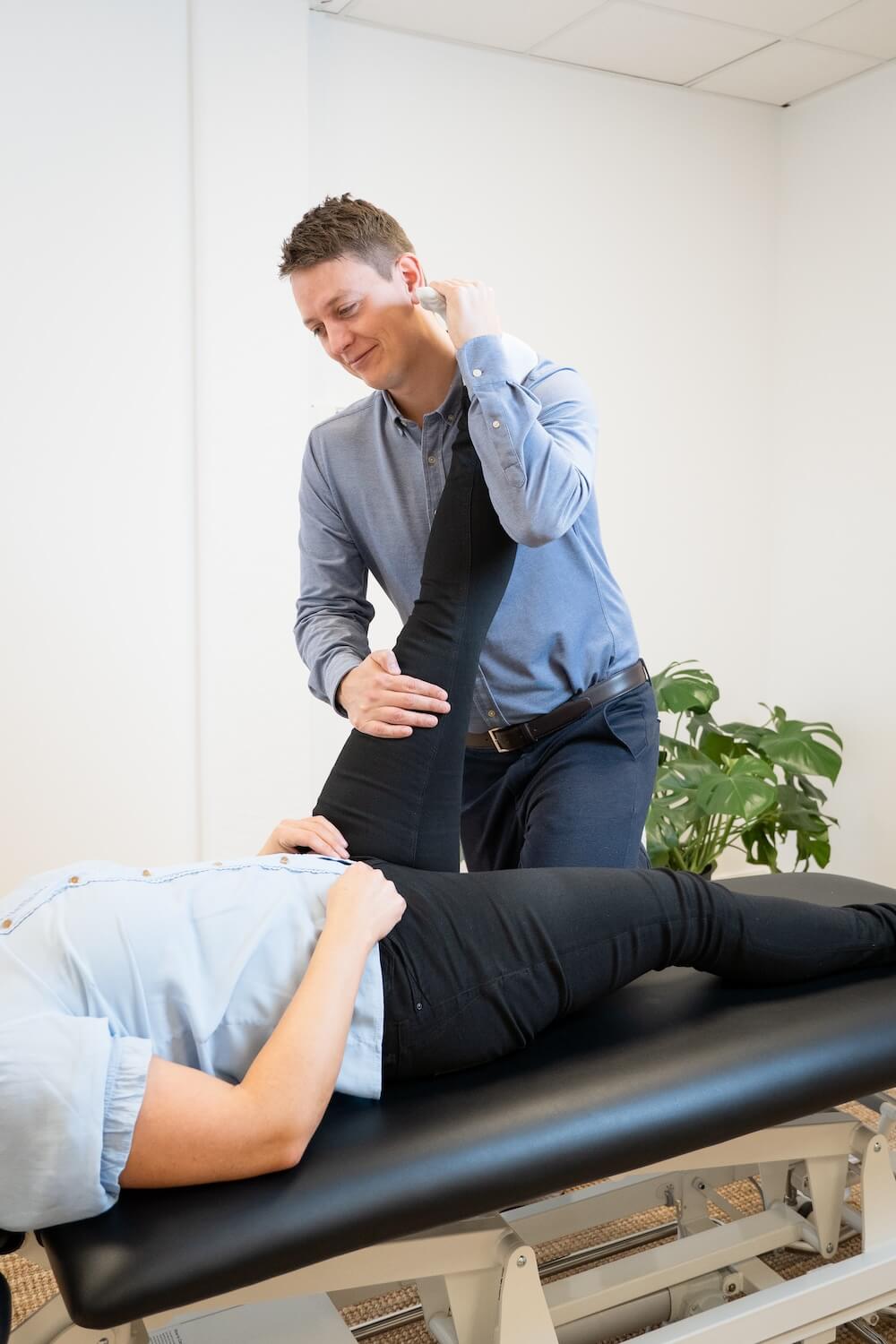We treat
Swollen ankles
Causes and treatment of swollen ankles
Swollen ankles
There can be many different causes of swollen ankles, most of which have a good prognosis. Swollen ankles can occur when venous blood is prevented from flowing back towards the heart. If swelling occurs in a single leg or foot, the underlying cause can typically be related to this one leg. In many cases, the cause can be due to reduced effectiveness of the venous valves, but can be due to other more serious factors. Therefore, it is important to get a thorough investigation for this.
Jump to section [Vis]
Causes of swelling
Swelling in both legs, feet or ankles is usually due to one or more causes elsewhere in the body. The veins from the legs run up through the pelvis, where they collect in the vena cava and run as one unit through the abdomen and up to the heart.
If the vena cava becomes compressed, this can affect the blood flow through the vein. As a result, venous blood will remain in the legs, increasing pressure on the veins.
Because of this, the fluid from the vein will diffuse into the organism, which can cause swelling and in some cases physical discomfort such as tenderness and reduced mobility, as it affects surrounding structures.
Diseases such as heart failure, high blood pressure, kidney failure, and diabetes can increase the risk of swelling in or around the ankles.

Understanding the Venous System
The venous system is responsible for transporting blood that has already supplied the body with oxygen back to the heart. This includes all the deoxygenated blood that needs to be recycled. Unlike the arterial system, which transports oxygenated blood out into the body, the venous system does not have muscle walls to push the blood back to the heart. Therefore, the veins depend on other structures to get the venous blood back to the heart.
In the legs there are venous valves that ensure that the blood does not flow back against gravity. It is important to point out that the venous valve system is only responsible for one third of the venous return. The primary “engine” that moves the venous blood from the lower extremities (legs and ankles) back to the chest and heart is our respiratory muscle, the diaphragm (“the diaphragm muscle”).
This happens by creating positive and negative pressure in the body, which pulls the blood back towards the chest and heart.
What symptoms are experienced with swollen ankles?
Discomfort from swollen ankles can include individual experiences locally around the ankle and foot joint itself, but also symptoms elsewhere in the body depending on the underlying cause of the swelling. Commonly, tenderness is seen in the fluid-filled area as the fluid affects and presses on the surrounding structures.
This can also lead to increased fatigue in the affected tissue, as it is constantly under external pressure from the fluid, which can result in reduced mobility in the affected joints and a disabling sensation in relation to physical activity.
Below are listed global symptoms or experiences that may occur when the venous system is affected:
- Skin changes, ulcers and varicose veins may indicate failure of the venous system.
- With symptoms such as fatigue, lack of fitness, coughing, difficulty breathing and palpitations, swelling may be related to heart problems.
- In the event of a blood clot in the leg, there will often be increased temperature and redness in the affected area.
- In the case of symptoms such as decreased appetite, lethargy, nausea, itchy skin, hiccups, thirst, mental changes, anemia, muscle cramps, and leg and joint discomfort, swelling may be related to kidney problems.
If you experience any of the above symptoms in connection with swelling in your ankles, feet, or legs, you should seek medical attention.
Swelling can also rarely be caused by a tumor in a lymph node, which can cause edema (swelling) due to the accumulation of lymph fluid in the lymph vessels. Such a tumor can be both benign and malignant (cancer). Swollen lymph nodes caused by cancer are usually not tender. You should be especially careful if you have been more tired than usual, have had heavy night sweats or have lost weight for no reason. In such cases, you should contact your doctor.

Why do swollen ankles occur?
The actual cause of swollen ankles is often unknown. However, it is known that it is primarily the kidneys, liver and heart, as well as a disturbed venous system, that can cause swelling.
Likewise, taking some types of medication can cause swelling. Among others, calcium blockers, which are used for high blood pressure and heart attacks.
It is not uncommon for there to be multiple causes for swelling. People with varicose veins are known to be more prone to swollen ankles, as varicose veins are damaged superficial veins.
Swollen ankles in pregnant women
Pregnant women often experience swollen ankles, which are typically not a sign of any serious underlying pathology. The reason for this is a major change in the body’s structures, which can lead to an impact on venous return in several places in the body. This impact occurs primarily due to the pressure relationship between the thoracic and abdominal cavities changing as the fetus grows and takes up more space in the pelvis.
This can make it difficult for blood to flow back through the pelvis to the chest and heart. However, it is important that pregnant women receive a thorough examination, as swollen ankles in combination with other symptoms can be a sign of pre-eclampsia.

Duration of swollen ankles
The duration of swollen ankles depends on the underlying cause. There is no general rule for how long you can experience swollen ankles, as it varies depending on the cause of the swelling. Other symptoms or discomfort, such as pain and reduced mobility, that occur in connection with swelling will typically subside as the swelling decreases.
If these symptoms do not go away when the swelling subsides, there may be another reason for these discomforts.
Treatment of swollen ankles, feet and legs
The treatment of swollen ankles, feet and legs is based on a thorough examination to identify the underlying cause of the swelling. At Osteonordic, treatment may include a combination of manual therapy and exercise.
The manual therapy is performed in one of our rooms, where a therapist will review the specific challenge you are facing to find the right treatment method for you.
Treatment focuses on identifying and treating the underlying cause so that the swelling does not recur.

Osteopathic approach to swollen ankles
Osteopathy takes a very holistic approach to treating the body, which also applies to swollen ankles. It is essential to first identify the specific cause of the swelling in order to offer the best treatment.
Osteopathy focuses on using the body’s own natural healing mechanisms and optimizing these to achieve the most natural and side-effect-free treatment.
To optimize the body’s own healing mechanisms, an osteopath will investigate whether there are factors that prevent this. This involves assessing possible influences on the neurological system, musculoskeletal system, circulatory system, hormonal system, gastrointestinal system and the psychological system, as problems in these areas can prevent optimal healing.
The treatment starts with an in-depth conversation about you and your symptoms to create the best basis for the subsequent examination. The osteopath will also try to uncover other systemic influences that may contribute to the persistence of the problem.
The focus will be on addressing specific structures in the body that may be causing the swelling.
Typical areas included in treatment of swollen ankles
- The pelvis and its joint mobility: Mechanical restrictions here can reduce the possibility of natural venous return.
- Pelvic organs (bladder, uterus, and rectum): Ineffective venous return from these structures can compress the veins from the legs. It is important that the pelvic organs and the membranes around them are mobile and pliable. Conditions that can affect this include endometriosis, menstrual problems in women, and digestive problems as the peritoneum adheres to the pelvic organs.
- Liver and kidney: It is important to ensure optimal function and mobility of these organs, as well as to assess the strain on them from factors such as alcohol, medications, lack of sleep and stress. This can affect both circulatory function and the ability to control it.
- Lumbar and lumbosacral nerves: Examination of possible nerve irritation that may increase tone (tension) in the tissue around the blood vessels.
- Mobilizing techniques for the ribs, mid-back, and respiratory muscles: These are important as the respiratory muscle, as mentioned above, is the primary motor for moving venous blood around the body.
Good advice if you suffer from swollen ankles
General conditioning is an effective tool as it promotes blood circulation and can help reduce swelling. Activities can range from a walk to a soccer game, depending on what your body can tolerate.
Working on the mobility of the mid-back, breathing exercises and improving the mobility of the pelvis and its structures can also contribute to symptom relief.
Additionally, salt plays a role in regulating the fluid balance in the body. Too much table salt (sodium chloride) can contribute to swelling as it binds fluid. Alcohol can reduce potassium levels in the body, which impairs the sodium/potassium balance. High alcohol intake also puts a strain on the liver, which produces proteins to regulate pressure in the blood vessels. Therefore, it is beneficial to avoid alcohol and large amounts of salt.
There are many factors, such as liver and kidney function, that can affect the body’s internal pressure. An osteopath can help identify which factors need to be adjusted in terms of diet and lifestyle.

Often related injuries

Tenosynovitis in the foot

Swollen ankles

Sunken forefoot

Flat Foot (Pes Valgus)

Ankle and foot pain

Heel spur

